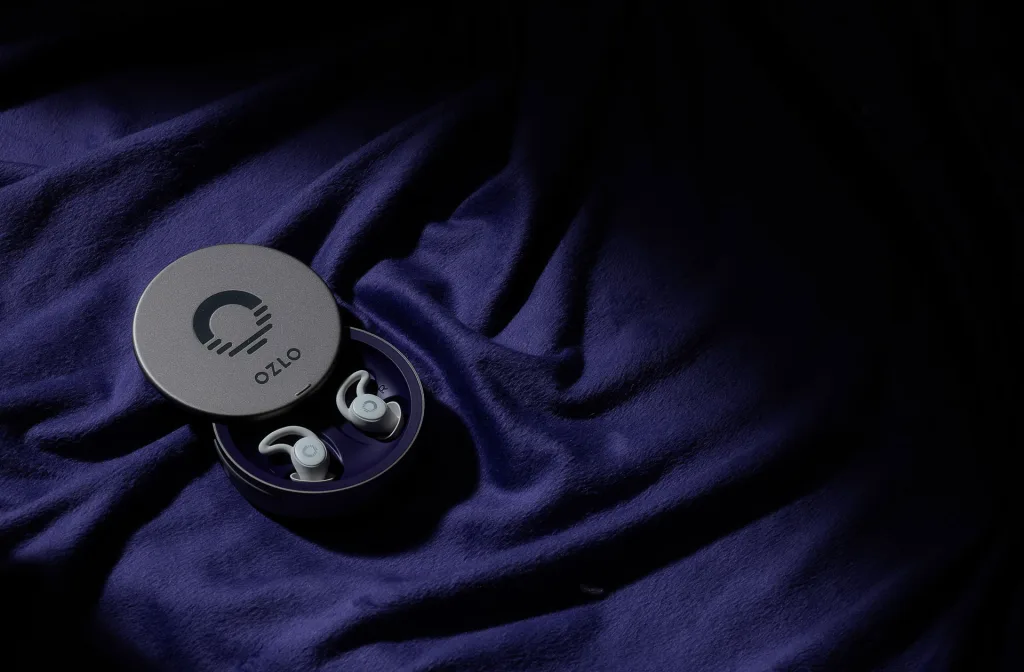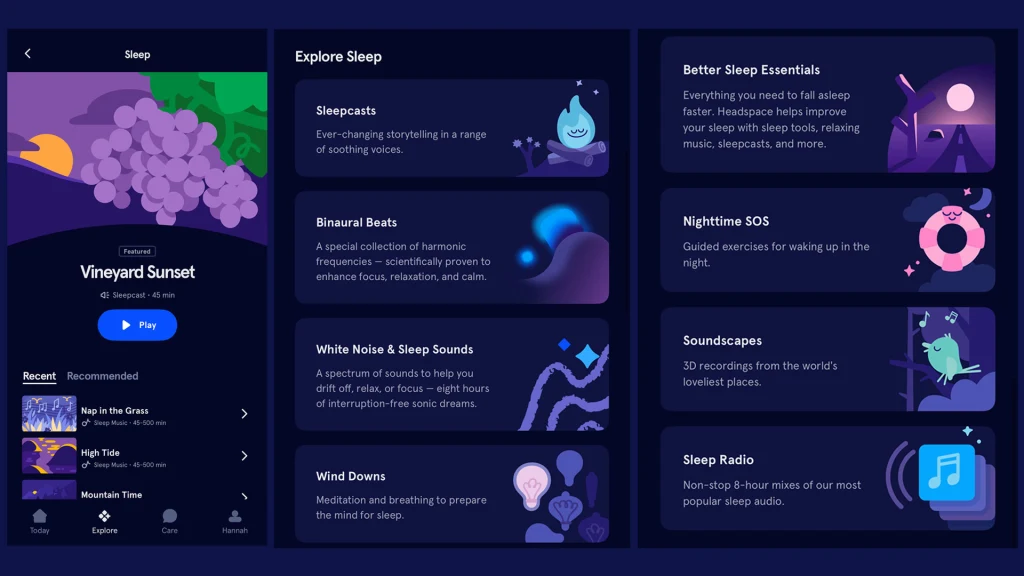Ever wonder why the sound of rain makes you instantly drowsy, but a ticking clock drives you up the wall? That’s because not all noise soothes the brain in the same way. Sleep sounds might seem like just background buzz, but they’re carefully engineered to allow your brain to let go. Behind every babbling brook or rainforest storm track is an intricate design meant to quiet the mind, block out distractions, and nudge you toward sleep.
As more people rely on sleep sounds to wind down, the industry behind them has surged, which is evidence of just how common this nightly ritual has become. Mediation and mindfulness app Headspace, says 51% of listeners use its sleep content (the app has been downloaded more than 70 million times).
Ozlo, a company that created bluetooth earbuds that mask noise with sleep sounds, launched its flagship product in October 2024 after a successful Kickstarter. Since then, the company has sold nearly 100,000 units worldwide. Meanwhile, platforms like YouTube and Spotify are packed with “deep sleep” playlists, sound baths, and endless loops of ambient noise.
Color noise—white, brown, or pink, which emit sound energy at different frequencies—can be surprisingly effective at helping you fall and stay asleep. But we often oversimplify how they work, says Ethan Cohen, a music and sound composer at Ozlo Sleepbuds, and these sounds alone aren’t a cure-all.

“There’s often this tendency to say, this sound does X, Y, or Z. But you don’t just press a button and conk out,” he says. “They’re facilitating the conditions for healthy sleep or relaxation. They’re giving you your best chance at sleeping well.”
A lot of what makes a sound effective is personal. “People tend to like certain frequency ranges based on nature,” says Scott Sorenson, audio engineer for Headspace. “White noise is what rain sounds like—it’s really high pitched. Brown noise is a much lower frequency range—it sounds like you’re underwater or even in the womb. We all have that maternal connection.”
Memory plays a huge role, too. If you grew up next to a highway, the rumble of trucks might feel oddly soothing. If your childhood nights were filled with crickets and light wind, even the low hum of traffic might keep you awake. “There’s a lot of preference involved based on what is happening in the person’s life and in their environment,” Cohen says.
That’s why both Ozlo and Headspace have built full libraries of sleep sounds—to meet people where they are. Sound composers like Cohen and Sorenson go way beyond simple static. They build immersive sound environments: layers of familiar, soothing textures help create a feeling of safety and ease, quietly occupying the mind just enough to help you drift off.
Inside the craft of sleep sound design
Building the perfect sleep sound is part science, part art. And most sounds are designed to serve two main purposes: mask disturbances (like traffic or snoring), and calm the mind.
Ozlo’s most popular request is for sleep masks—sounds built specifically to block out noisy environments. To design one, Cohen studies how these external sleep disturbances sound at a frequency level. “I look at what the noise sounds like on its own. Then what it sounds like once our headphones are sitting in your ears,” he says. From there, he builds layers to cover the gaps, often at a similar frequency as the offending sound.
“The goal is that any time an external sound is also heard, it just blends into that bed of sound,” he says. “We’re gently raising the threshold of what sounds a person is hearing so that if something does bubble up in their external environment, nothing pokes through the quiet and causes a disturbance.”
Calming tracks that quiet racing thoughts take a slightly different approach. Instead of just covering up noise, they aim to transport you somewhere else—somewhere your brain instinctively feels safe. “It should evoke positive or calming memories,” says Cohen.
[carousel_block id=”carousel-1747168293067″]
Sorenson describes this process as constructing an “audio diorama”: layering field recordings, ambient noise, and subtle musical motifs to build a miniature world for a listener’s mind to explore. “I want to create things that are hidden inside of the sound. That if you listen, you can peel back the layers and go deeper and deeper,” he says. “That kind of mindset allows the mind to drift into that other space when we sleep.”
Right now, Cohen is working on re-creating the experience of being on a train. He started with a field recording he made on a recent ride—that becomes the foundation. Then, he gets deeper to fill in the gaps that the audio didn’t pick up: “What materials is the train made out of? Does it feel like a safe, well-running train? Does it feel crowded?” he asks. Every detail matters, even if listeners don’t consciously recognize it.
Once he sets the scene, Cohen begins layering in other sounds: rain tapping against the window (either digitally created or carefully edited from a sample), the soft chatter of other passengers, intermittent gusts of wind, the distant call of a train horn. “Those will all be separate elements that I’m mixing together to create a sense of realism,” he says.
Keeping the brain engaged—but not awake
Even though personal preference shapes what we find soothing, good sleep sounds share a few key traits.
First: predictability. “A well-studied aspect of what makes something relaxing is that there’s formal predictability,” says Cohen. “There won’t be anything that is surprising or shocking or jolting in the experience.” Think about how a sudden car alarm or barking dog snaps you wide awake.
But too much predictability backfires. “If it’s too simple, too monotonous, it becomes annoying,” says Sorenson. Think of the maddening tick of a clock or rhythmic drip of a faucet. The best sounds strike a balance: steady enough to be calming, but varied enough to keep your brain gently engaged. Rain is a classic example. “If you listen to the rain, there’s an immense amount of randomness and variation within a larger predictable phenomenon,” says Cohen.

Another detail most listeners won’t consciously notice: the key of the music itself. Sorenson has found that sleep sounds built around major keys—rather than minor ones—tend to feel lighter and more relaxing.
The best sleep sounds don’t just drown out the world—they create a new one that’s easy to get lost in. And right now, they’re one of the gentlest tools we have to improve sleep. In a world obsessed with quick fixes, Sorensen says, there’s something powerful about finding rest through creativity, memory, and sound.
“Art is important. Sound and music have a healing effect on people,” says Sorenson. “Potentially at some point, there could be a pill for everything. But right now, this is what we have.”
Zaloguj się, aby dodać komentarz
Inne posty w tej grupie

The new must-have pet accessory? A concrete slab.
On #CatTok, videos are racking up views as cat owners bring slabs into their homes, set them down, and watch their beloved pets sniff, l


OpenAI is rolling out a new AI agent within ChatGPT that can browse th

Mark Zuckerberg and current and former directors and officers of Meta Platforms agreed on Thursday to settle claims seeking $8 billion for the damage they allegedly caused the company by allowing

Welcome to AI Decoded, Fast Company’s weekly newsletter that breaks down the most important news in

Holders of the digital tokens issued by World Liberty Financial, one of the

The use of AI companions is no longer niche behavior but has become em
